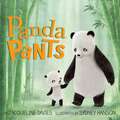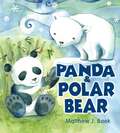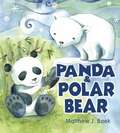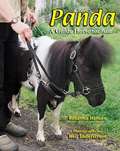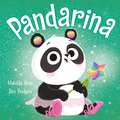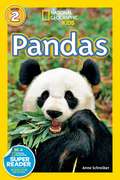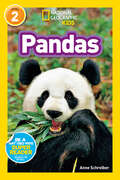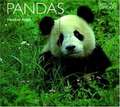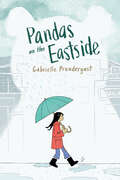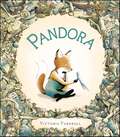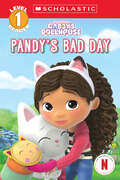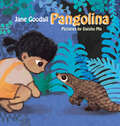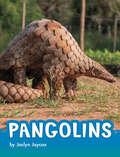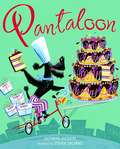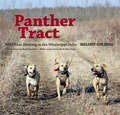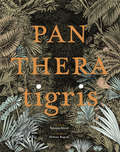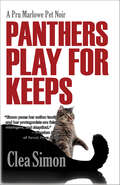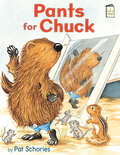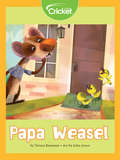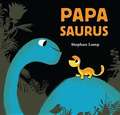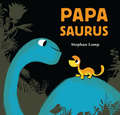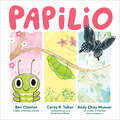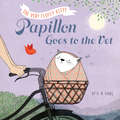- Table View
- List View
Panda Pants
by Jacqueline DaviesWith spot-on humor, a spare text, and adorable panda bear characters, this is a fun and familiar exchange between a parent and child that fans of I DON'T WANT TO BE A FROG! will easily relate to! I want pants, says a little panda to his father. You are a panda, answers the father. Pandas do NOT wear pants. And so begins a hilarious battle of wills when a young panda tries to convince his father why pants make perfect sense. After all, pants are soft. Pants keep you warm. Some pants even have . . . POCKETS! But with a menacing snow leopard lurking in the background, will the longed-for pants end up having an even greater role to play? Jacqueline Davies&’s humorous story, with deliciously droll illustrations from Sydney Hanson, captures the push and pull between a parent and child as they face off over the age-old dilemma of what to wear . . . with the most heartwarming of results.
Panda and Polar Bear
by Matthew BaekA little polar bear wonders what?s beyond his wintry world?and when he falls over the edge of an ice cliff, he finds out! He?s soon befriended by a panda who mistakes the mud-covered polar bear for one of his own. The two become quick pals. But what happens when the polar bear?s muddy splotches wash off? Will the two bears stay friends? From the much lauded author of Be Gentle with the Dog, Dear! comes a clever take on a timeless theme. With plenty of heart and humor?plus a gratifying surprise ending?kids are sure to flip back to the beginning for more.
Panda and Polar Bear
by Matthew J. BaekA little polar bear wonders what's beyond his wintry world and when he falls over the edge of an ice cliff, he finds out! He's soon befriended by a panda who mistakes the mud-covered polar bear for one of his own. The two become quick pals. But what happens when the polar bear's muddy splotches wash off? Will the two bears stay friends? From the much lauded author of Be Gentle with the Dog, Dear! comes a clever take on a timeless theme. With plenty of heart and humor plus a gratifying surprise ending, kids are sure to flip back to the beginning for more. <P><P>Lexile Measure: 500L
Panda: A Guide Horse for Ann
by Rosanna HansenPanda, is only about 29 inches tall, and has four hooves and a tail. She works as a guide for Ann Edie, just as dogs do. Learn about this cute little horse and how she was trained and works.
Panda: An Intimate Portrait Of One Of The World's Most Elusive Characters
by Heather AngelA photographic tribute to the panda, featuring details on their home, feeding behavior, mating habits, and survival in the face of human encroachment. With its large, friendly face and eyes exaggerated by black eye patches, China&’s national treasure, the giant panda, is instantly recognizable. Giant pandas spend most of their time trying to eat enough bamboo to survive. The rest is spent conserving energy, and solitary pandas can be seen strolling along, stopping to recline on riverside rocks or amongst ferns. The lower body-weight and physical size of panda cubs mean that they have more energy to spend, and are seen climbing trees, play-fighting, doing somersaults and playing with bamboo. Panda is a unique and intimate portrait of one of the world&’s best-loved animals. The extraordinary lives of the giant panda and the enchanting red panda are captured throughout the seasons in their remote mountain habitat. This selection of over two hundred remarkable pictures shows pandas feeding, resting, playing, climbing trees and even sliding down snowy slopes, as well as showcasing the misty peaks and snow-clad forests of the beautiful Sichuan Province of China. Panda is a heart-warming and illuminating tribute to an endangered species that is loved the world over.
Pandarina (The Magic Pet Shop #6)
by Matilda RosePrincess Skye is SO clumsy. There's no way she can dance at Queen Elsie's birthday ball with all her friends! But waiting for her at Mrs Paws' Magic Pet Shop is a pet who might just change her mind . . . Pandarina is a magical panda who LOVES to dance. Can Pandarina help Princess Skye find her feet?From the creators of Pugicorn comes a sparkling picture book about trying your best and never giving up! *WITH A SPECIAL GLITTERY COVER*Discover other books in the Magic Pet Shop series:PugicornPugicorn and the Christmas WishStarwhalLa-La-Llama
Pandas
by Anne SchreiberThe whole world loves panda bears. Everyone loves to watch them play, climb, cuddle, and chew. But careful, they can scratch too--just look at that tree! Pandas live in wild places very faraway, and they are the STAR ATTRACTIONS of every zoo that keeps them safe and well, all over the world. National Geographic supports K-12 educators with ELA Common Core Resources. Visit www. natgeoed. org/commoncore for more information.
Pandas (Nature's Children)
by Merebeth SwitzerIn this book you will learn about the Giant panda, and its cousin the Lesser Panda of China.
Pandas (Readers)
by Anne SchreiberThe whole world loves panda bears. Everyone loves to watch them play, climb, cuddle, and chew. But careful, they can scratch too—just look at that tree! Pandas live in wild places very far away, and they are the STAR ATTRACTIONS of every zoo that keeps them safe and well, all over the world.National Geographic supports K-12 educators with ELA Common Core Resources.Visit www.natgeoed.org/commoncore for more information.
Pandas (WorldLife Library)
by Heather Angel"Pandas" is a fascinating introduction to these popular yet seldom-seen animals. Join wildlife photographer and zoologist Heather Angel on her personal adventure as she journeys into the depths of China to catch a glimpse of the endangered giant panda and the red panda. From this collection of glorious photographs and descriptive text, you'll learn details about the panda's eating habits, habitat, and behavior, as well as conservation issues relating to its survival and endangered species status. Heather Angel trained as a zoologist and worked as a marine biologist before becoming a professional wildlife photographer. She has visited China twelve times, including four visits specifically to photograph pandas. While she was president of the Royal Photographic Society, she led a small British photographic delegation to China in 1985, when an exhibition of her wildlife photographs was staged in Beijing. In 1994, she was appointed a special professor at Nottingham University, where she teaches part of the photography module. In 1998, she was elected as the Louis Schmidt Laureate by the Biological Photographic Association. Professor Angel lives in England.
Pandas on the Eastside
by Gabrielle PrendergastWhen ten-year-old Journey Song hears that two pandas are being held in a warehouse in her neighborhood, she worries that they may be hungry, cold and lonely. <P><P>Horrified to learn that the pandas, originally destined for a zoo in Washington, might be shipped back to China because of a diplomatic spat between China and the United States, Journey rallies her friends and neighbors on the poverty-stricken Eastside. Her infectious enthusiasm for all things panda is hard to resist, and soon she's getting assistance from every corner of her tight-knit neighborhood.
Pandora
by Victoria TurnbullPandora lives alone, in a world of broken things. She makes herself a handsome home, but no one ever comes to visit. Then one day something falls from the sky . . . a bird with a broken wing. Little by little, Pandora helps the bird grow stronger. Little by little, the bird helps Pandora feel less lonely. The bird begins to fly again, and always comes back—bringing seeds and flowers and other small gifts. But then one day, it flies away and doesn't return. Pandora is heartbroken. Until things begin to grow . . . Here is a stunningly illustrated celebration of connection and renewal.
Pandy's Bad Day (Scholastic Reader, Level 1)
by Ms. Gabrielle ReyesFind out all about Pandy Paws's big feelings in this sweet Level 1 Reader from the world of DreamWorksGabby's Dollhouse!Gabby receives a special Dollhouse Delivery for Pandy Paws. The only problem? He's having a very bad day. The Gabby Cats help him find ways to make his day better, but nothing seems to be working. Will Pandy learn that it's okay to have bad days? Find out in this adorable Level 1 Reader!This Level 1 reader is perfect for beginning readers who are learning to sound out and decode words.DreamWorks Gabby's Dollhouse © 2024 DreamWorks Animation LLC. All Rights Reserved.
Pangolina
by Jane GoodallFrom legendary naturalist Jane Goodall, an absorbing fictional tale that will steal hearts and open minds about the plight of the pangolin, the only mammalian species with scales, and endangered by illegal trafficking.After a blissful babyhood being cared for by her loving mother, Pangolina ventures out alone into the forest to become an independent adult, helped along by wise, older animal companions, including a civet and a bat. But one day cruel hunters trap Pangolina, putting her into a cage along with her friends, and bring them to a market to be sold as wild game. Pangolina is especially vulnerable, since her scales are prized by humans who believe they have curative powers. To the rescue comes a small girl who knows that pangolins are friendly fellow creatures who have feelings too, and who convinces her mother to buy Pangolina and set her free. Jane Goodall's many followers and all animal-loving children and adult picture book fans will be riveted by this suspenseful and heartwarming fictional story set in China and including an authoritative informational page about pangolins and suggestions for how to help fight animal trafficking.
Pangolins (Animals)
by Jaclyn JaycoxPangolins’ bodies are a rare sight. They have scales, spikes, and claws! Bright photos bring these unusual mammals to life. Readers will follow along with easy-to-read text and will enjoy learning all they can about pangolins.
Pantaloon
by Kathryn JacksonPantaloon is a poodle with a sweet tooth. He adores cookies and yummy pastries. So when the Baker is looking for a helper, Pantaloon applies for the job."Oh, no, Pantaloon!" says the Baker. "You look to me as if you'd eat more than you'd bake." But Pantaloon proves him wrong in this charming Golden classic, brilliantly reillustrated by Steven Salerno.From the Hardcover edition.
Panther Tract: Wild Boar Hunting in the Mississippi Delta
by Melody GoldingHunting wild boar is a keenly held tradition in the Mississippi Delta. Fraught with danger, it challenges the hunter, observer, wildlife enthusiast, and landowner alike. Panther Tract is an insider's observance of extraordinary hunting, southern hospitality, camaraderie, and the love of dogs, horses, and hair-raising excitement. The over 160 photographs are representative of a “day at the hunt,” starting at dawn and ending well after dark. The tales center on vivid hunting experiences, both at Panther Tract, a large wilderness paradise in Yazoo County, owned by legendary southern gentleman Howard Brent, and in other locations in the Mississippi Delta. The narratives come from men, women, doctors, lawyers, judges, businessmen, politicians, farmers, sharecroppers' sons, and even a Hollywood screenwriter. Melody Golding's photographs focus on the Delta landscape and on the people and animals involved in the hunt. Portraits of the hunters, and their interactions with one another and their dogs and horses, fascinate. An award-winning photographer and an expert horsewoman, Golding brings a knowledgeable and critical eye to these images. The stories she collects range from traditional often humorous hunting tales to more serious accounts of the history of hog hunting in America. Hank Burdine, a Mississippi native and hunter who has written for many statewide publications, lends a broad vision to the history, statistics, and lore of hunting wild hogs. An appendix features hunt recipes by Chef John Folse and philosophy on the stewardship of harvesting the hog. A colorful and diverse assemblage of beautiful photographs and tales, this book reveals a treasured regional tradition.
Panthera Tigris
by Sylvain AlzialWhile reading an encyclopedia, a highly educated scientist realizes that he doesn&’t know anything about tigers! He begins studying them until he can rattle off every tiger fact imaginable, including their habitat (jungles and marshy areas), their average weight (300-500 pounds), and their scientific name (Panthera tigris). But when he hires a guide to take him to see a tiger in person, the scientist discovers that he might not quite know everything.With deadpan humor and illustrations that perfectly complement the story, Panthera Tigris will delight nature lovers and budding scientists.
Panthers Play for Keeps: A Pru Marlowe Pet Noir (Pru Marlowe Pet Noir #4)
by Clea SimonA shooter takes deadly aim, and throws a city into panicPsychologist Daniel Rinaldi is no stranger to trauma. A survivor of not one, but two attempts on his life by a deranged killer, the therapist also counsels trauma patients in his private practice, and contracts with the Pittsburgh Police to help victims of violent crime cope with their experience. When a sports mascot is gunned down mid-field by a sniper at a college football game he attends, Rinaldi becomes an accidental yet integral part of the investigation. To begin with, the victim in the costume is not the person who was supposed to be wearing it.When the actual "Teasdale Tiger" hears the news, he suffers a crippling panic attack and calls on Rinaldi to talk him through it. From there, Rinaldi seems to be in all the wrong places at all the wrong times, as the sniper continues his killing spree. Meeting with resistance from members of the Pittsburgh Police force and taking dangerous risks in pursuit of the killer, Rinaldi puts his career and his life in harm's way as he races to find a connection between the victims before the shooter strikes again.
Pants for Chuck (I Like to Read)
by Pat SchoriesBig Chuck, a woodchuck, is playing with Rabbit, Raccoon, Chipmunk, and the mice brothers when he spots a pair of blue pants. Chuck must have them. He holds up the game while he struggles to put them on. "You are too big and the pants are too small," his friends tell him, but Chuck thinks he looks spiffy. Sidesplitting illustrations show a determined Chuck, stuffed into his much-too-tiny blue pants and trying in vain to keep up. Comfort and fun finally trump fashion as Chuck sheds the pants and joins the gang for a game of hide and seek. A story about self-image and true friends. An I Like to Read(R) book. Guided Reading Level E.
Papa Weasel
by Teresa BatemanSly the weasel thinks he's going on a simple nest raid to steal eggs for an omelet. But when ducklings hatch from the stolen eggs, Sly becomes Papa and his big adventure begins.
Papasaurus
by Stephan LompBabysaurus loves playing hide-and-seek with his Papasaurus. But one day, no matter where he looks, he can't find him, so Babysaurus turns to his prehistoric friends for help. Where can his Papasaurus be? Of course, Papasaurus has been right there all along, and when Babysaurus needs a little help, Papasaurus is ready with a big kiss and more games. This colorful and reassuring book is a fresh twist on a perennial theme that will win the hearts of little ones and their papas alike.
Papasaurus
by Stephan LompBabysaurus loves playing hide-and-seek with his Papasaurus. But one day, no matter where he looks, he can't find him, so Babysaurus turns to his prehistoric friends for help. Where can his Papasaurus be? Of course, Papasaurus has been right there all along, and when Babysaurus needs a little help, Papasaurus is ready with a big kiss and more games. This colorful and reassuring book is a fresh twist on a perennial theme that will win the hearts of little ones and their papas alike.
Papilio
by Ben Clanton Corey R. Tabor Andy Chou MusserA tale told in three parts by three friends! Powerhouse creators, Ben Clanton, Corey R. Tabor, and Andy Chou Musser, have come together to create a wholly inventive picture book that is perfect for fans of The Very Hungry Caterpillar.Introducing Papilio Polyxenes, the Black Swallowtail Butterfly! She&’s an adorable and hilarious caterpillar who is ready to join the world and become a butterfly! But growing up is a complicated work in progress, and Papilio encounters some hiccups as she learns to fly, fall, and feed. While avoiding foes and making friends, she transforms from caterpillar, to chrysalis, to butterfly...and most importantly, learns to believe in herself along the way.Told in three parts and complete with backmatter about butterflies, mega-bestselling author-illustrator Ben Clanton (Narwhal and Jelly), Caldecott Honoree Corey R. Tabor (Mel Fell) and rising star Andy Chou Musser (Ploof) have come together to create an expressive character who exudes all of the emotions that accompany life's big firsts and the experiences that help us to discover our inner strength.
Papillon Goes to the Vet (Papillon #2)
by A. N. KangPapillon, the kitty so fluffy he floats, is back! Only this time, he's grounded. Literally. Weighed down after swallowing a toy and beset with hiccups, Papillon is miserable! Miss Tilly takes him to the vet, but will he ever float again?
